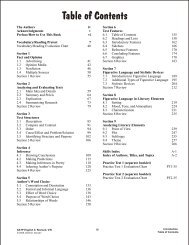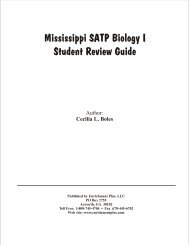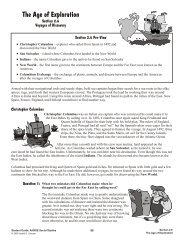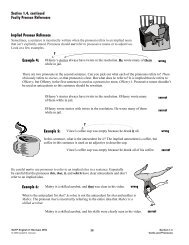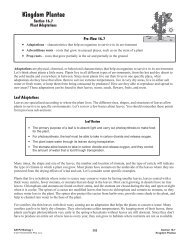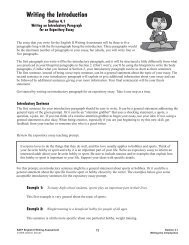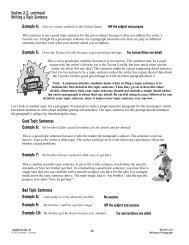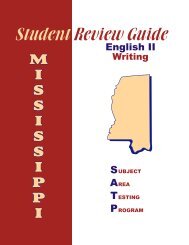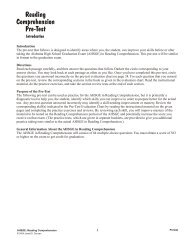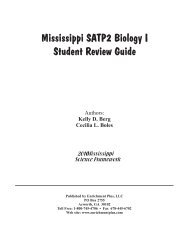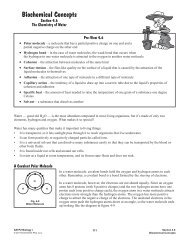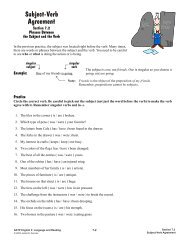Biology I Pre-Test - Enrichment Plus
Biology I Pre-Test - Enrichment Plus
Biology I Pre-Test - Enrichment Plus
You also want an ePaper? Increase the reach of your titles
YUMPU automatically turns print PDFs into web optimized ePapers that Google loves.
<strong>Biology</strong> I<br />
<strong>Pre</strong>-<strong>Test</strong><br />
Introduction<br />
Introduction<br />
The pre-test that follows is designed to identify areas where you can improve your skills before or after taking the<br />
<strong>Biology</strong> I end-of-course test. This pre-test will be similar in format to the Mississippi SATP2 end-of-course test for<br />
<strong>Biology</strong> I.<br />
Directions<br />
Read the directions on the following page. These directions should be similar to what you will see on the actual<br />
SATP2 end-of-course test for <strong>Biology</strong> I. Once you have completed this pre-test, circle the questions you answered<br />
incorrectly on the pre-test evaluation chart on page 30. For each question that you missed on the pre-test, review the<br />
corresponding sections in the book as given in the evaluation chart. Read the instructional material, do the practice<br />
exercises, and take the section review tests at the end of each section.<br />
Scoring the <strong>Pre</strong>-<strong>Test</strong><br />
The following pre-test can be used as practice for the SATP2 <strong>Biology</strong> I test, but it is primarily a diagnostic tool to help<br />
you identify which skills you can improve in order to prepare better for the actual test. Any pre-test question answered<br />
incorrectly may identify a skill needing improvement or mastery. Review the corresponding skill(s) indicated in the<br />
<strong>Pre</strong>-<strong>Test</strong> Evaluation Chart by reading the instructional material on the given pages and completing the practice<br />
exercises and reviews. By reviewing each skill, you will improve mastery of the material to be tested on the SATP2<br />
<strong>Biology</strong> I test and potentially increase the score you receive on that test. (The practice tests, which are given in<br />
separate booklets, are provided to give you additional practice taking tests similar to the actual SATP2 <strong>Biology</strong> I test.)<br />
SATP2 <strong>Biology</strong> I<br />
© 2011 <strong>Enrichment</strong> <strong>Plus</strong>, LLC<br />
7 <strong>Pre</strong>-<strong>Test</strong>
1 The bottle of a chemical used in a biology<br />
laboratory is labeled with the following symbol.<br />
4 Look at the pedigree graphic below.<br />
KEY<br />
normal<br />
male<br />
normal<br />
female<br />
affected<br />
male<br />
carrier<br />
female<br />
What does this laboratory safety symbol indicate<br />
about the chemical?<br />
A<br />
B<br />
C<br />
D<br />
It should be heated first before it is used.<br />
It evaporates easily and should be used only<br />
under a vent hood.<br />
It is corrosive and should not be allowed to<br />
contact the skin.<br />
It is flammable and should not be used around<br />
open flames.<br />
This pedigree shows that only males are affected<br />
by a certain disorder. What type of inheritance is<br />
indicated by the pedigree?<br />
F<br />
G<br />
H<br />
J<br />
recessive<br />
dominant<br />
incomplete<br />
sex-linked<br />
A B C D<br />
F G H J<br />
2 Which of the following is NOT found in a<br />
carbohydrate?<br />
5 Which two processes cycle carbon and oxygen<br />
between living organisms?<br />
F<br />
Carbon<br />
A<br />
Oxidation and combustion<br />
G<br />
Hydrogen<br />
B<br />
Transpiration and condensation<br />
H<br />
Nitrogen<br />
C<br />
Pollination and fertilization<br />
J<br />
Oxygen<br />
D<br />
Cellular respiration and photosynthesis<br />
F G H J<br />
A B C D<br />
3 In which circumstance would a high rate of<br />
mutation in a population be beneficial to the<br />
population?<br />
6 Millions of acres of rainforests are destroyed<br />
each year. Which of the following is a negative<br />
result of this human activity?<br />
A<br />
B<br />
C<br />
D<br />
Only if the environment is very stable<br />
Only if the environment is changing rapidly<br />
Only if the environment is changing very<br />
slowly over a long period of time<br />
In any environment regardless of its stability<br />
F<br />
G<br />
H<br />
J<br />
A decrease in atmospheric carbon dioxide<br />
A decrease in biodiversity<br />
An increase in atmospheric oxygen<br />
An increase in precipitation<br />
A B C D F G H J<br />
SATP2 <strong>Biology</strong> I<br />
© 2011 <strong>Enrichment</strong> <strong>Plus</strong>, LLC<br />
9 <strong>Pre</strong>-<strong>Test</strong>
30 A diagram of a food web is shown below.<br />
grass insect frog snake<br />
Which of the following organisms gets the MOST energy directly from the sun?<br />
F<br />
G<br />
H<br />
J<br />
frog<br />
grass<br />
insect<br />
snake<br />
F G H J<br />
31 The graph below is a climatogram of Limon, Costa Rica.<br />
450<br />
Climatogram of Limon, Costa Rica<br />
40<br />
400<br />
30<br />
Avg. Monthly<br />
<strong>Pre</strong>cipitation (mm)<br />
350<br />
300<br />
250<br />
200<br />
150<br />
20<br />
10<br />
0<br />
–10<br />
–20<br />
Avg. Monthly<br />
Temperature (°C)<br />
100<br />
–30<br />
50<br />
–40<br />
<strong>Pre</strong>cipitation<br />
Jan Feb Mar Apr May Jun Jul Aug Sep Oct Nov Dec<br />
–50<br />
Temperature<br />
Which behavioral adaptation would be seen in animals in this biome?<br />
A<br />
B<br />
C<br />
D<br />
Likely to hibernate during winter months<br />
<strong>Pre</strong>fer to live in trees to escape predators<br />
Dig deep underground tunnels to get to water<br />
Likely to migrate during dry months<br />
A B C D<br />
SATP2 <strong>Biology</strong> I<br />
© 2011 <strong>Enrichment</strong> <strong>Plus</strong>, LLC<br />
16 <strong>Pre</strong>-<strong>Test</strong>
<strong>Biology</strong> I<br />
<strong>Pre</strong>-<strong>Test</strong><br />
Evaluation Chart<br />
Circle the questions you answered incorrectly on the chart below, and review the corresponding sections in the book. Read the<br />
instructional material, do the practice exercises, and take the section review tests at the end of each section.<br />
If you missed<br />
question #:<br />
1<br />
2<br />
3<br />
4<br />
5<br />
6<br />
7<br />
8<br />
9<br />
10<br />
11<br />
12<br />
13<br />
14<br />
15<br />
16<br />
17<br />
18<br />
19<br />
20<br />
21<br />
22<br />
23<br />
24<br />
25<br />
26<br />
27<br />
28<br />
29<br />
30<br />
Go to<br />
section(s):<br />
1.7<br />
5.2<br />
14.1, 14.2<br />
10.1, 10.2, 10.3, 11.3, 11.4<br />
8.2, 8.3, 8.4, 18.2, 18.3<br />
21.4<br />
2.1<br />
5.6<br />
14.2<br />
19.2, 19.3, 19.4<br />
15.1, 15.2, 15.3, 16.1<br />
4.2, 4.3, 4.4, 4.5, 4.6, 5.1<br />
6.2, 6.3<br />
17.7<br />
10.1, 10.2, 11.3<br />
14.1, 14.2<br />
10.1, 10.2, 10.3<br />
16.6<br />
21.4<br />
3.1<br />
14.1, 14.2<br />
13.3<br />
16.1, 16.2, 16.3<br />
4.6<br />
17.1, 17.2, 17.3, 17.4, 17.5, 17.6<br />
10.1, 10.2<br />
4.7, 5.6<br />
12.1, 12.2<br />
7.2<br />
19.3, 19.4<br />
If you missed<br />
question #:<br />
31<br />
32<br />
33<br />
34<br />
35<br />
36<br />
37<br />
38<br />
39<br />
40<br />
41<br />
42<br />
43<br />
44<br />
45<br />
46<br />
47<br />
48<br />
49<br />
50<br />
51<br />
52<br />
53<br />
54<br />
55<br />
56<br />
57<br />
58<br />
59<br />
60<br />
Go to<br />
section(s):<br />
17.8, 20.1, 20.2<br />
12.3<br />
6.2, 6.3, 8.2, 8.3<br />
1.6, 1.7<br />
9.1<br />
13.4<br />
9.1<br />
3.1<br />
16.7, 20.1<br />
9.2<br />
2.3, 2.4<br />
17.8, 20.3<br />
4.7<br />
13.2<br />
9.2, 12.4<br />
6.2<br />
14.2, 14.3, 14.4<br />
4.7<br />
8.1, 8.2, 8.3<br />
12.3<br />
5.4<br />
17.7, 17.8, 20.1, 20.2, 20.3<br />
17.8, 20.2<br />
1.1, 1.3<br />
10.1, 10.2<br />
1.5<br />
9.4<br />
21.1, 21.4<br />
2.1, 2.2, 2.3<br />
6.1<br />
If you missed<br />
question #:<br />
61<br />
62<br />
63<br />
64<br />
65<br />
66<br />
67<br />
68<br />
69<br />
70<br />
71<br />
72<br />
73<br />
74<br />
75<br />
76<br />
77<br />
78<br />
79<br />
80<br />
81<br />
82<br />
83<br />
84<br />
85<br />
Go to<br />
section(s):<br />
12.1<br />
11.3, 11.4<br />
9.1<br />
6.4, 16.6<br />
14.4, 14.5<br />
10.1, 10.2, 11.2<br />
13.2<br />
2.3<br />
10.1, 10.2, 11.1<br />
15.2, 15.4, 19.3<br />
10.1, 10.2, 10.3, 11.4<br />
18.4<br />
12.5<br />
19.2<br />
12.5, 13.5<br />
7.3<br />
13.1<br />
12.2, 12.4<br />
6.4<br />
13.4<br />
9.1, 9.2, 9.3<br />
15.1<br />
16.6<br />
6.4<br />
14.1, 14.2<br />
SATP2 <strong>Biology</strong> I<br />
© 2011 <strong>Enrichment</strong> <strong>Plus</strong>, LLC<br />
30 <strong>Pre</strong>-<strong>Test</strong>



